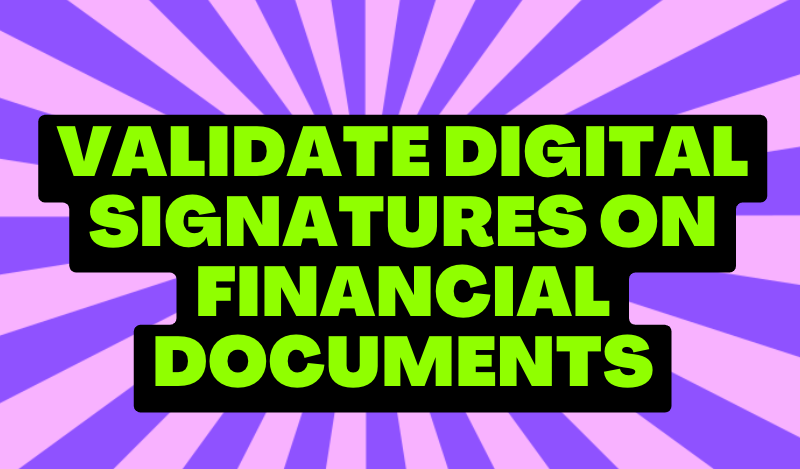In the modern digital landscape, ensuring the authenticity and security of financial documents has become a top priority.
Digital signatures offer greater protection than conventional handwritten signatures, making their validation essential for confirming the legitimacy of financial documents.
This article will delve into the ins and outs of validating digital signatures, helping you gain confidence in the documents you handle with this innovation.
What Makes Digital And Electronic Signatures Different?
Digital signatures employ encryption technology to safeguard electronic documents. These signatures confirm the signer’s identity and ensure that the document has not been altered post-signing.
Conversely, electronic signatures are merely digital representations of handwritten signatures and lack the advanced security features of digital signatures.
Checking the validity of a digital signature is a crucial step in establishing the reliability of any financial document.
Acquiring And Creating Digital Signatures
To validate a digital signature, you must first obtain a digital signature certificate (DSC) from a reputable certificate authority (CA).
A DSC is an electronic document that houses the public key and other signer details and confirms the signature’s authenticity.
When creating your digital signature, various online tools simplify the process. One such tool is a signature generator, which allows you to create a unique digital signature that can be easily added to your financial documents.
By utilizing such tools, you can ensure the authenticity and security of the documents you sign without relying on external resources or services.
Digital Signatures In Business And Legal Contexts
Integrating digital signatures into your business operations can streamline processes and enhance security.
Start by choosing a reliable digital signature solution that suits your specific needs and requirements. Then, implement a clear policy for using it within your organization and provide training to ensure all employees understand the process and its importance.
Digital signatures have legal implications, as they help establish the validity and enforceability of electronic documents. Familiarize yourself with the regulations governing digital signatures in your jurisdiction. Likewise, ensure that your chosen digital signature solution complies with these requirements.
Maintaining security throughout the digital signature process is paramount. Safeguard sensitive data by using robust encryption methods and keeping your private keys secure. Also, regularly update your digital signature software to protect against emerging threats and vulnerabilities.
Validating Digital Signatures And Overcoming Common Challenges
By following this step-by-step guide, you can confidently validate digital signatures and tackle any common issues that may arise.
- Open the document: Begin by accessing the financial document containing the digital signature using a compatible software application that supports signature validation.
- Identify the digital signature: Locate the digital signature, typically represented as a small icon or a signature field within the document. Clicking this icon or field should display information about the signature, including the signer’s name and the validation status.
- Evaluate the signature status: A valid signature will show a message confirming its authenticity and indicating that the document has not been modified since signing. In contrast, an invalid signature or a tampered document will result in an error message or warning.
- Inspect the DSC: To ensure the credibility of the digital signature, verify the DSC used to sign the document. This can be done within the signature validation software by clicking the certificate information or manually cross-checking the DSC with the issuing CA’s database.
At times, you may face issues when validating digital signatures. Common obstacles include expired certificates, untrusted CAs, or improperly formatted signatures. Determine the source of the problem and take the necessary action, such as updating the certificate, adding the CA to your trusted list, or requesting a new signature from the signer.
Assessing Digital Signature Solutions And Their Impact On Money Management
Numerous digital signature solutions on the market boast distinct features and capabilities. When evaluating which one to use, consider factors such as user-friendliness, compatibility with existing software and systems, security features, and adherence to applicable regulations.
Furthermore, consider the solution’s capacity to scale and support your organization’s growth.
Digital signatures greatly impact money management, offering extra security and validation for financial transactions.
By adopting digital signatures, businesses and individuals can ensure the integrity of their financial documents, reduce the risk of fraud, and expedite the approval process. This ultimately results in enhanced financial management and a strengthened trust among parties participating in financial transactions.
Know The Ideal Solutions
The validation of digital signatures on financial documents is a crucial step for preserving the security and integrity of electronic transactions. By grasping the subtleties of digital signatures, selecting the appropriate solution, and implementing proper validation procedures, you can reinforce your organization’s security and effectively manage your finances in today’s digital era.

Krishna Murthy is the senior publisher at Trickyfinance. Krishna Murthy was one of the brilliant students during his college days. He completed his education in MBA (Master of Business Administration), and he is currently managing the all workload for sharing the best banking information over the internet. The main purpose of starting Tricky Finance is to provide all the precious information related to businesses and the banks to his readers.



